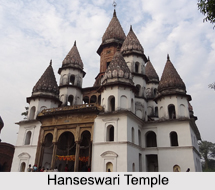 Situated in the town of Banshberia at Hooghly District, the Hanseswari Temple is a Hindu temple of goddess Hanseswari. Rani Hanseswari was the mother of Raja Nrisingha Deb Roy; hence the deity is worshipped as Maa Hanseswari. The deity is worshipped in the avatar of Goddess Kali. It was King Nrisingha Dev Rai who started to build the famous Temple of Hanseswari, but, soon after his death in 1802, it was his wife Rani Shankari who completed the temple construction in 1814 as a tribute to her late husband.
Situated in the town of Banshberia at Hooghly District, the Hanseswari Temple is a Hindu temple of goddess Hanseswari. Rani Hanseswari was the mother of Raja Nrisingha Deb Roy; hence the deity is worshipped as Maa Hanseswari. The deity is worshipped in the avatar of Goddess Kali. It was King Nrisingha Dev Rai who started to build the famous Temple of Hanseswari, but, soon after his death in 1802, it was his wife Rani Shankari who completed the temple construction in 1814 as a tribute to her late husband.
History of Hanseswari Temple
In the mid-16th century after the Mughal conquest of Bengal, the city started to decline due to the loss of royal patronage, but some areas such as Banshberia continued to prosper up to the 19th century, sponsored by semi-independent zamindars who built several temples in the area. Among these is the Hanseswari Temple built in 1814. It is said that while staying in Varanasi from 1792 to 1798, King Nrisingha Dev was a follower of a Tantric cult, where he studied the six cyclic centres or the six chakras of the human body. This form of rite is also known as the Kundalini in Shashtra. The shrine in Banshberia is a great example of the Kundalini and yogic concepts. Even the deity has been designed and installed following the concept of Yoga and Pranayam. The word Hong is pronounced at the time of breathing out whereas the word "S-a-a" is uttered at the time of breathing in. Hong manifests Shiva and "S-a-a" represents Mother Shakti.
Architecture of Hanseswari Temple
The Hanseswari Temple has a distinctive architecture which is different from the usual pattern present in the Banshberia area, consisting of 13 minars or ratnas, each built as a blooming lotus bud having the height of 27.5 m. The architecture of the temples is the representation of Tantric Satchakrabhed. The inner structure of the building resembles human anatomy that has Ida, Pingala, Bajraksha, Sushumna and Chitrini.
The temple houses both the idols of Lord Shiva and Devi Shakti and thus comes the name Hanseswari. Image of white Shiva is found to be lying on six triangular marbles. From the navel of Mahadeva, a lotus stem has come out carrying twelve petals blood-red lotus. On this, the 4 handed Mother Shakti stands on her right leg while resting the left leg on her right thigh. The upper left hand carries a sword to represent her power to slay the demons and the lower left one carries a severed head of a demon; the upper right palm is posed in a Fearless-Mudra also known as the Abhaya Mudra so as to depict her as the Protector of the world from the evils whereas the lower right hand is posed in a way as if to offer her blessings to all, which is called the Bar-Mudra. The deity is blue in colour and made of wood derived from Neem tree. The room beneath the central minar has a white marbled Shiva lingam.
Next to the Hanseswari Temple is the Ananta Basudev Temple which was constructed by Rameshwar Datta in 1679. This temple follows the typical eek – ratna style of Bengal Temple architecture, where the temple is crowned with a single pinnacle. The pinnacle of the Ananta Basudev Temple is octagonal. Dedicated to Lord Krishna, this temple has beautiful terracotta panels portraying an interesting mix of religious figures like Goddess Kali, Durga and Lord Krishna along with panels of boats and ships, dancing girls, scenes from war and last but not least scenes from daily life.
Visiting Information on Hanseswari Temple
The Banshberia railway station is at a mere distance of 1 km from the temple and has trains connecting from Banshberia to Howrah.











